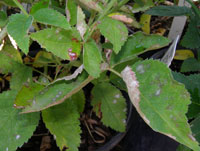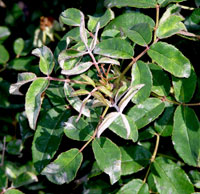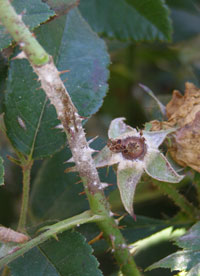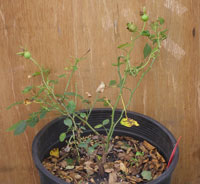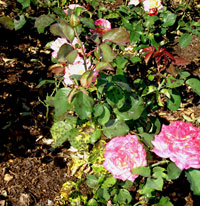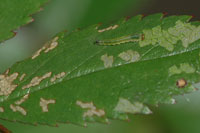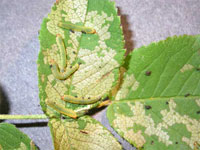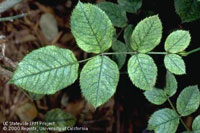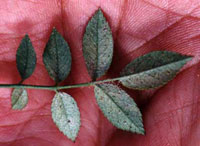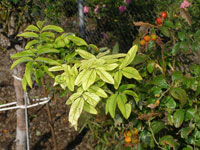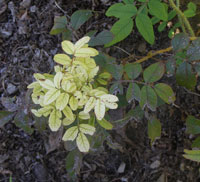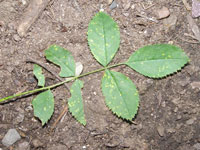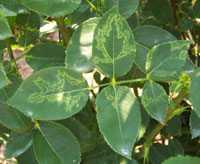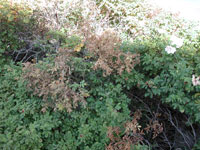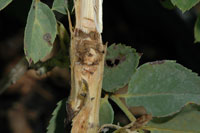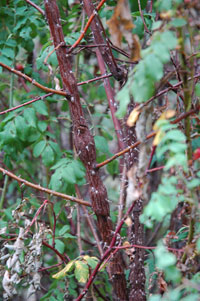Extension > Garden > Diagnose a problem > What's wrong with my plant? > Annuals and Perennials > Roses > Discolored leaves
Roses > Leaves > Discolored leaves
1 of 10
Powdery Mildew
Sphaerotheca pannosa
- Powdery white coating on leaves, stems, flower buds and flower stalks
- Leaf tissue may be tinted red around the infection
- Leaves can be twisted or curved at the site of infection
- Infection often most severe on young leaves
- Typically occurs mid to late summer
- More information on powdery mildew
2 of 10
Black Spot
Diplocarpon roseae
- Purplish black spots with uneven or feathery edges on leaves
- Leaves turn yellow around spots
- Leaves fall off
- Sometimes reddish purple or black blisters on canes
3 of 10
Roseslug
- Occurs during May and June
- Creates windowpane damage (i.e. feeds on one layer of leaf tissue between the veins)
- Clear, lacey damage at first, later turns brown
- Green, smooth caterpillar-like body, up to 1/2 inch long
- More information on Roseslug
4 of 10
Spider Mites
- Occurs during summer, especially during hot, dry weather
- Leaves are a speckled, off-green color
- As damage becomes more severe, leaves become a bronzed color
- Yellowish or greenish color; found on underside of leaves; very tiny (1/50th inch long) and not easily seen without magnification
- More information on Spider Mites
5 of 10
Iron chlorosis
Deficiency of iron in leaves
- Leaves are pale green to white with darker green veins
- Young leaves more affected than old leaves
- In severe cases, young leaves are small and completely white
- Common in rugosa roses
6 of 10
Rust
Phragmidium mucronatum
- Orange raised bumps on underside of leaves
- Twisted or bent leaves, with orange lesions
- Powdery orange spores released from all lesions and spots
- Severely infected leaves may wilt
- More information on rust
7 of 10
Virus
Rose Mosaic Virus
- Unusual yellow wavy lines, circles, spots or mottling on leaves
- Symptoms are most obvious in cool weather in spring and fall, may become faint in the heat of summer
- Leaves can be leathery, wrinkled or distorted
- Plants can be stunted or grow poorly
8 of 10
Rose Streak
Rose Streak Virus
- Symptoms are most common on roses with large clusters of small flowers
- Symptoms may vary in other cultivars
- Leaves turn yellow and may have random dead brown spots
- Leaves fall off in the spring or early summer
- Very susceptible cultivars have brown to black streaks on the canes
9 of 10
Rose stem girdler
- Occurs during summer
- Clumps of leaves wilt and turn brown
- Also look for swelling in stem
- Small (1/4 inch long), bullet-shaped, iridescent gold; rarely seen
10 of 10
- - NO PHOTO AVAILABLE -
Salt burn
Excessive fertilizer or deicing salt
- Edges of leaves are brown and dry
- Roots are dead and brown from the tip back
- Plants are stunted and have slow growth
- Common in plants close to roads or sidewalks, and in heavily fertilized plants



